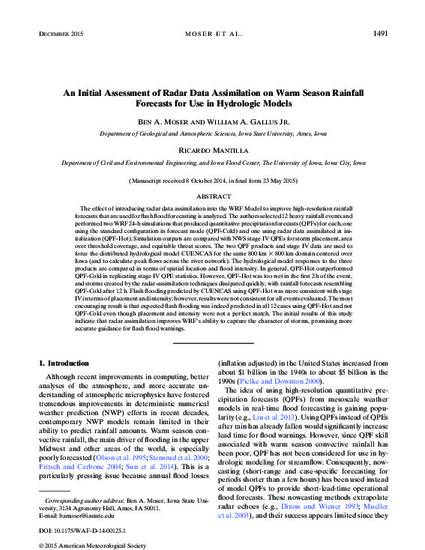
The effect of introducing radar data assimilation into the WRF Model to improve high-resolution rainfall forecasts that are used for flash flood forecasting is analyzed. The authors selected 12 heavy rainfall events and performed two WRF 24-h simulations that produced quantitative precipitation forecasts (QPFs) for each, one using the standard configuration in forecast mode (QPF-Cold) and one using radar data assimilated at initialization (QPF-Hot). Simulation outputs are compared with NWS stage IV QPEs for storm placement, area over threshold coverage, and equitable threat scores. The two QPF products and stage IV data are used to force the distributed hydrological model CUENCAS for the same 800 km × 800 km domain centered over Iowa (and to calculate peak flows across the river network). The hydrological model responses to the three products are compared in terms of spatial location and flood intensity. In general, QPF-Hot outperformed QPF-Cold in replicating stage IV QPE statistics. However, QPF-Hot was too wet in the first 2 h of the event, and storms created by the radar-assimilation techniques dissipated quickly, with rainfall forecasts resembling QPF-Cold after 12 h. Flash flooding predicted by CUENCAS using QPF-Hot was more consistent with stage IV in terms of placement and intensity; however, results were not consistent for all events evaluated. The most encouraging result is that expected flash flooding was indeed predicted in all 12 cases using QPF-Hot and not QPF-Cold even though placement and intensity were not a perfect match. The initial results of this study indicate that radar assimilation improves WRF’s ability to capture the character of storms, promising more accurate guidance for flash flood warnings.
Available at: http://works.bepress.com/william_gallus/61/

This article is published as Moser, Ben A., William A. Gallus Jr, and Ricardo Mantilla. "An initial assessment of radar data assimilation on warm season rainfall forecasts for use in hydrologic models." Weather and Forecasting 30, no. 6 (2015): 1491-1520. DOI: 10.1175/WAF-D-14-00125.1. Posted with permission.